Rust Family Foundation: Archaeology Grants Program
Testing the Neolithic-Chalcolithic transition in the southern Levant: Exploring the earliest levels of Tel Tsaf
Principal Investigator: Prof. Danny Rosenberg
Zinman Institute of Archaeology, University of Haifa, Mount Carmel, Israel
The Chalcolithic period in southwest Asia is a time of momentous social, political and economic change as the small egalitarian farming villages of the Neolithic period developed into larger and more structured entities. These, in turn, were the basis for the first territorial city-states of the Early Bronze Age. Apart from innovations in metallurgy, the Chalcolithic presents changes in household economies, craft specialization and cult, designating this timespan as a key period for the emergence of social stratification in the southern Levant.
Scholars still disagree on criteria that demarcate the Neolithic and Chalcolithic periods, and this ambiguity fostered a variety of terms for the same time-span (e.g. Early, Middle and Late Chalcolith
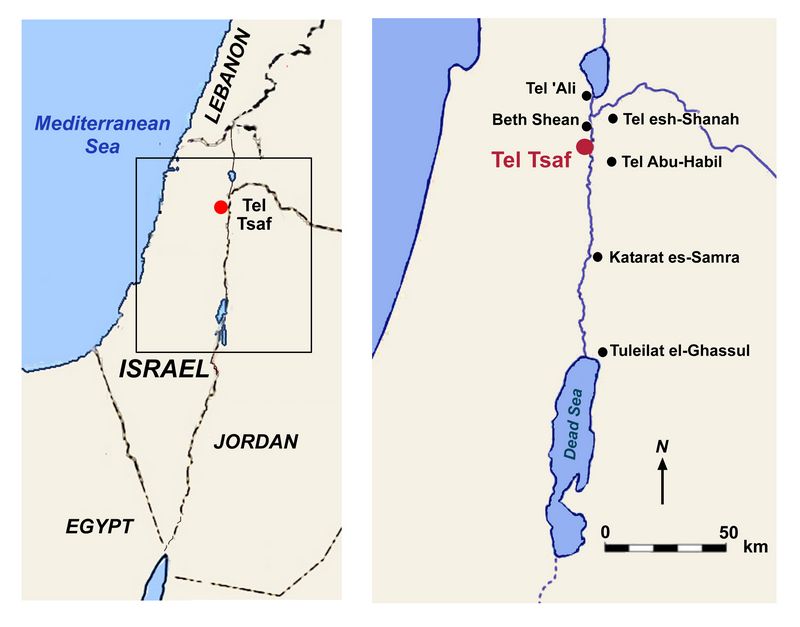 ic) and related cultures (e.g. Wadi Rabah, Jericho VIII,
Qatifian, Nazurian, Besorian and see discussions in Garfinkel 1999, 2009;
Gilead 1990, 2007, 2009; Lovell et al. 2007; Rosenberg 2011). While
these are mainly problems of nomenclature that reflect a shortage of
empirical data, this information deficit hampers clear analysis of the
social and economic characteristics of the time-span and the changes
they underwent.
ic) and related cultures (e.g. Wadi Rabah, Jericho VIII,
Qatifian, Nazurian, Besorian and see discussions in Garfinkel 1999, 2009;
Gilead 1990, 2007, 2009; Lovell et al. 2007; Rosenberg 2011). While
these are mainly problems of nomenclature that reflect a shortage of
empirical data, this information deficit hampers clear analysis of the
social and economic characteristics of the time-span and the changes
they underwent. Fig.1: Location of Tel Tsaf and contemporary sites in northern Israel and Jordan.
Crucial data on this transtion can be obtained at Tel Tsaf, a ca. five hectares site located near Kibbutz Tirat Tzvi in northern Israel (fig.1). The main gap in the study of Tel Tsaf since the 1970’s relates to the earliest formative phases of the settlements; these hold the answers to some of the main questions regarding the beginning of the settlement and its development into a flourishing community that maintained long-distance trade connections and managed to accumulate large scale agricultural surpluses. Now with the advance of our multidisciplinary project, we have the opportunity to explore these formative layers of the Tel.
Previous Research at the site.
Tel Tsaf was first reported in the survey of the region during the 1940’s and 1950’s. The site received little attention until recently. Notably, the site brings significant evidence for dramatic social and economic shifts during this time-span. Area C forms the main excavation area (fig.2). The area strata include layers of densely built architecture with the remains of four large courtyard buildings. The results of the 2004–2007 excavations showed that the upper level of Area C should be dated to ca. 7,200–6,700 cal BP. Among the notable finds unearthed are extensive and complex mudbrick architecture, large mudbrick installations interpreted as silos and many dug cooking facilities confined within the courtyard structures.
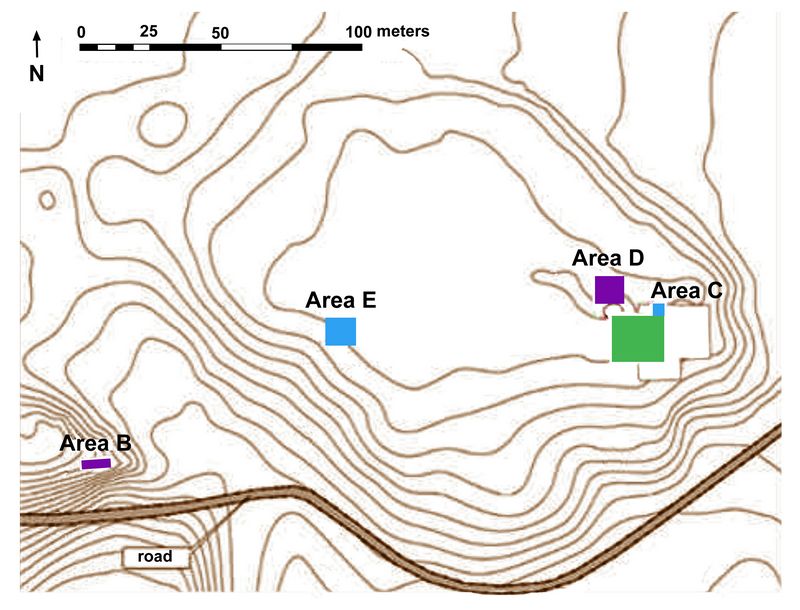 Upper levels at Tel
Tsaf yielded a large pottery
assemblage, including a collection of specially decorated
pottery bearing the so-called ‘Tel Tsaf decoration’ that reflects a
Halafian influence (Gophna and Sadeh 1988–1989; Kaplan 1960) and is
known from only a few other sites such as Tell Abu Habil, Tell
esh-Shunah and Kataret es-Samra in Jordan (fig.1; see Garfinkel 1999: fig. 114
and references therein).
Upper levels at Tel
Tsaf yielded a large pottery
assemblage, including a collection of specially decorated
pottery bearing the so-called ‘Tel Tsaf decoration’ that reflects a
Halafian influence (Gophna and Sadeh 1988–1989; Kaplan 1960) and is
known from only a few other sites such as Tell Abu Habil, Tell
esh-Shunah and Kataret es-Samra in Jordan (fig.1; see Garfinkel 1999: fig. 114
and references therein). Fig.2: Plan of Tel Tsaf showing main excavation areas.
Among the notable finds from Tel Tsaf is a copper awl that was found in one of the silo burials (Garfinkel et al. 2014). Several other artifact types also reflect long-distance trade or exchange networks with Anatolia (obsidian items), northern Syria/Mesopotamia (pottery sherds of the ‘Ubaid style) and Egypt (Nilotic shells). Shells from the Mediterranean Sea and the Red Sea were also found as well as various rock fragments with a provenance in southern Jordan. A clay silo model (Rosenberg et al. 2017), stone stamp seals, dozens of clay seals and unique stone and clay figurines were noted as well as many objects made of quartzite, whorls, some of which were made from exotic material, and thousands of beads made of various minerals, ostrich-egg shell and obsidian. Flint and ground stone tools are common, mainly reflecting local traditions and on-site production.
The advantages of Tel Tsaf as a focal point for research on the Neolithic- Chalcolithic transition and the related evidence for culinary preferences, agriculture intensification and the environmental and cultural backgrounds, include the extraordinary preservation of architecture, storage, cooking and roasting installations and the associated botanic and faunal remains. These include wood, seeds (e.g. Graham 2014), phytoliths, pollen, starch and organic residues as well as a diverse assemblage of animal bones (e.g. Hill 2011) representing herd animals, wild fauna, micro-vertebrate, fish and avifauna as well as molluscs. These remains enable a comprehensive and well-dated reconstruction and evaluation of complimentary data sets concerning dietary practices, food-related technologies and intensified agriculture as well as paleo-environmental reconstructions. The superb mudbrick architecture (Rosenberg et al. 2020) enables a precise, reliable and contextual sampling strategy, and the site is nearly undisturbed by post-mid-5th millennium cal. BC activity; thus, the pertinent layers are well-preserved and protected.
2020 Funded Research Project (RFF-2021-143)
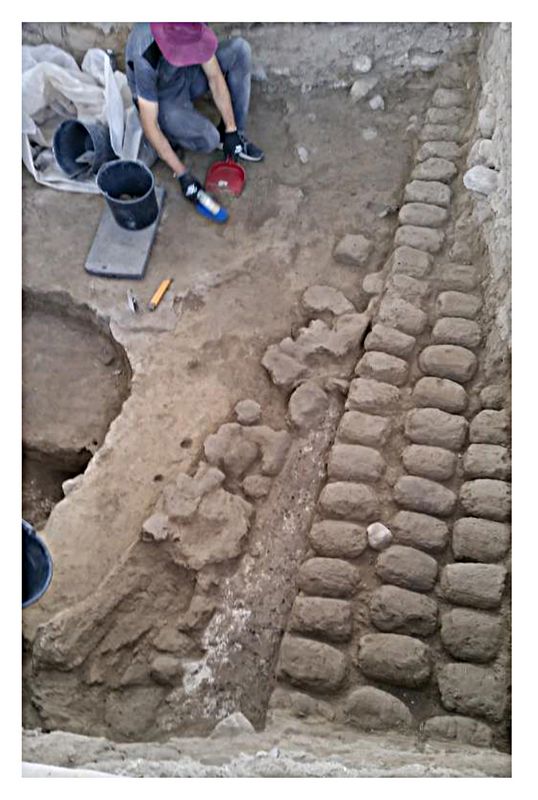 Goals:
Goals: The goals of the current project are to explore the site as a laboratory for human behavior by analyzing socio-economic changes through time and provide new insights into the unexplored formative stages of Tel Tsaf. The research addresses the question of differential resource management and the use of space through the early occupational sequence of Tel Tsaf, and in order to better understand the social and economic characteristics of the Neolithic–Chalcolithic transition in the Jordan Valley.
Fig.3: Two of the successive mudbrick walls at Tel Tsaf and a plaster floor
The proposed research was designed to achieve the following objectives:
1) generate independent evidence for economic change and variation in the use of space between consecutive households at Pre-Ghassulian Tel Tsaf and 2) delineate and evaluate the attributes and the nature of the change at a single site and the relevant social and environmental factors. These goal were met through a multidisciplinary high-resolution contextual examination of the earliest levels of the site. This season we were able, for the first time, to reach the geological levels upon which the earliest occupation at the site was formed.
Methodology:
To explore the characteristics of the earliest formative phases of Tel Tsaf, we conducted a focused excavation season on the deep cut we initiated in Area C. We
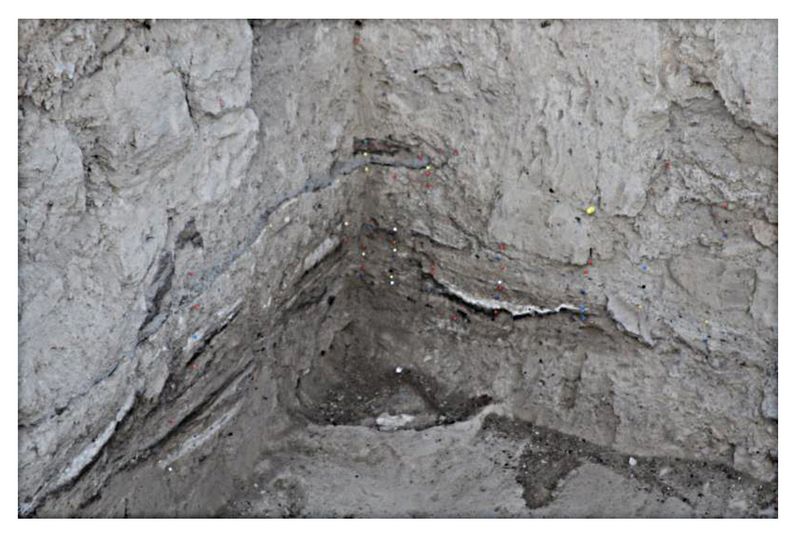 excavated directly below the earliest layers we
encountered so far, ca. 2.7 meters below the site surface using the
results of our 2013–2019 excavations as references for the upper parts
of the sequence.
excavated directly below the earliest layers we
encountered so far, ca. 2.7 meters below the site surface using the
results of our 2013–2019 excavations as references for the upper parts
of the sequence.Fig.4: Successive ashy layers in the southeastern section of Area C.
During the 2020 excavation season, we explored 20.0 m2 in the deep cut to a total depth of 0.5 m, where virgin soil was noted. We excavated using state-of-the-art methods and a high-resolution excavation methodology. Our basic field methodology includes small (1×1 m) excavation units, sifting in 2.0 mm sieves, total station based recording and the use of GIS software (ArcGIS). To build a GIS model, mapping of the archaeological features was performed using a combination of survey-grade-GPS defined control points and mapping using a total station. These models contain spatial coordinates for both the site grid as well as each locus defined during excavation. Intensive C14 sampling was performed screening based on contextual information.
Findings:
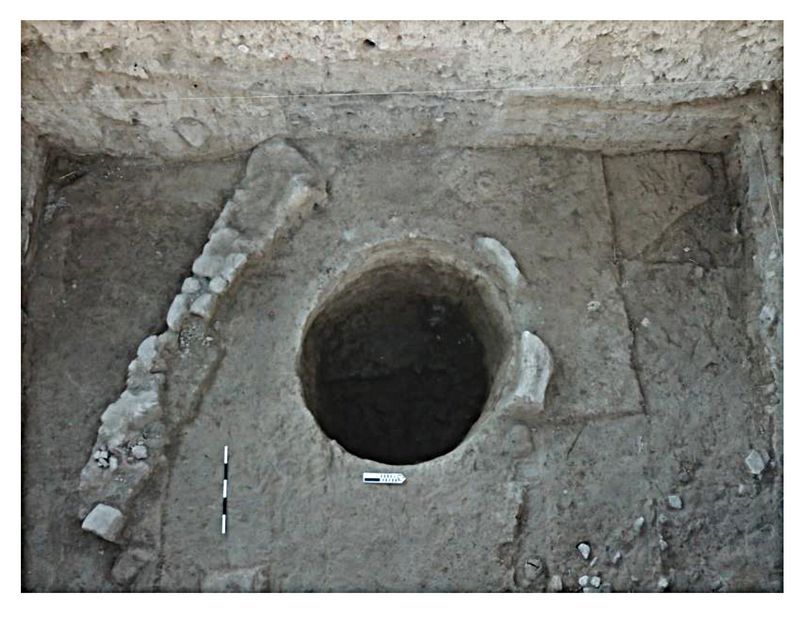 Our
main findings are related to the earliest levels of the site (Figures
3-5). We encountered first hand data on the original occupation levels,
and we are now confident that the site was inhabited for the first time
during the Middle Chalcolithic period. There is no indication for an
Early Chalcolithic presence.
Our
main findings are related to the earliest levels of the site (Figures
3-5). We encountered first hand data on the original occupation levels,
and we are now confident that the site was inhabited for the first time
during the Middle Chalcolithic period. There is no indication for an
Early Chalcolithic presence. Fig.5: The earliest wall at Tel Tsaf and the pit/well.
Several interesting finds in these early levels include various constructions and the presence of a deep pit, or a well (fig.5), first revealed during the last days of the season. This should be further excavated next season, as it may have acted as a trap for material culture and environmental data alike.
Conclusions
By pairing high-resolution documentation with state-of-the-art methods and analytical techniques, the study expands our current understanding of the earliest occupational levels of Tel Tsaf.
The data retrieved this season allow us to established that the earliest settlement of the site was founded around 5,300/5,200 cal BC and that most of the cultural markers that we see in the upper layers are also characteristic of the earliest levels. This in turn suggests that, at least in this area of the site, we cannot discern a true cultural development (or change); rather, our preliminary data reflects a continuous cultural sequence. Thus, the bearer of the Tsaf cultural markers evolved in the region and thrived for at least 500-600 years, before disappearing, leaving the site with no clear explanation.
Ongoing plans, including final publication
Our plans for the next four to five excavation seasons are to continue excavating the basal level of the site, and at the same time to test additional areas of the site that were never explored. The preliminary results of the current project suggest that a more complex and dense history of occupation was a prime characteristic of Area C, and we would like to test if this is indeed the case in other areas as well. The publication of the results of the current project is progressing and still awaits further data.
Bibliography:
Banning, E. B. 2002. Consensus and debate on Late Neolithic and Chalcolithic of the southern Levant. Paléorient 28:148–155.
Banning, E. B. 2007. Time and tradition in the transition from Late Neolithic to Chalcolithic: Summary and conclusions. Paléorient 33(1):137–142.
Bently, A., Earls, M. and O'Brian, M. J. 2011. I'll Have What She's Having. Mapping Social Behavior. Cambridge: MIT Press.
Blackham, M. 2002. Modeling Time and Transition in Prehistory: The Jordan Valley Chalcolithic (5500–3500 BC). BAR International Series 1027. Oxford: Archaeopress.
Bourke, S. J. 1997. The ‘Pre-Ghassulian’ sequence at Teleilat Ghassul. In: Gebel, H. G. K., Kafafi, Z. and Rollefson, G. (eds.) The Prehistory of Jordan II: Perspectives from 1997, Studies in Early Near Eastern Production, Subsistence, and Environment 4, pp. 395–417. Berlin: Ex-Oriente.
Garfinkel, A. 1999. Neolithic and Chalcolithic Pottery of the Southern Levant. Qedem 39. Monographs of the Institute of Archaeology. Jerusalem: The Hebrew University of Jerusalem.
Garfinkel, Y. 2009. The transition from Neolithic to Chalcolithic in the southern Levant: The material culture sequence. In: Shea, J. J. and Lieberman, D. E. (eds.) Transitions in Prehistory – Essays in Honor of Ofer Bar-Yosef, pp. 325–333. American School of Prehistoric Research, Peabody Museum, Harvard University. Oxford: Oxbow.
Garfinkel, Y., Ben-Shlomo, D., Freikman, M. and Vered, A. 2007. Tel Tsaf: The 2004–2006 excavation seasons. Israel Exploration Journal 57(1):1–33.
Garfinkel, Y., Ben-Shlomo, D. and Kuperman, T. 2009. Large-scale storage of grain surplus in the sixth millennium BC: The silos of Tel Tsaf. Antiquity 83:309–325.
Garfinkel, Y., Klimscha, F., Shalev, S. and Rosenberg, D. 2014. The beginning of metallurgy in the southern Levant: A late 6th millennium CalBC copper awl from Tel Tsaf, Israel. PLoS ONE 9(3): e92591. doi:10.1371/journal.pone.0092591.
Gilead, I. 1990. The Neolithic–Chalcolithic transition and the Qatifian of the northern Negev and Sinai. Levant 22:47–63.
Gilead, I. 2007. The Besorian: A Pre-Ghassulian cultural entity. Paléorient 33(1):33–49.
Gilead, I. 2009. The Neolithic–Chalcolithic transition in the southern Levant: Late Six-Fifth Millennium culture history. In: Shea, J. J. and Lieberman, D. E. (eds.) Transitions in Prehistory – Essays in Honor of Ofer Bar-Yosef, pp. 335–355. American School of Prehistoric Research, Peabody Museum, Harvard University. Oxford: Oxbow.
Gopher, A. and Gophna, A. 1993. Cultures of the eighth and seventh millennia BP in the southern Levant: A review for the 1990s. Journal of World Prehistory 7(3):297–353.
Gophna, R. and Sadeh, S. 1988–1989. Excavation at Tel Tsaf: An early Chalcolithic site in the Jordan Valley. Tel Aviv 15–16:3–36.
Graham, P. 2014. Archaeobotanical remains from late 6th/early 5th millennium BC Tel Tsaf, Israel. Journal of Archaeological Science 43:105–110.
Hill, A. C. 2011. Specialized Pastoralism and Social Stratification - Analysis of the Fauna from Chalcolithic Tel Tsaf, Israel. Unpublished Ph. D. Dissertation, University of Connecticut
Kaplan, J. 1960. The relation of the Chalcolithic pottery of Palestine to Halafian ware. Bulletin of the American Schools of Oriental Research 159:32–36.
Kerner, S. 2010. Craft specialization and its relation with social organization in the late 6th to early 4th millennium BC of the southern Levant. Paléorient 36(1):179–98.
Lovell, J., Dollfus, G. and Kafafi, Z. 2007. The ceramics of the Late Neolithic and Chalcolithic: Abu Hamid and the burnished tradition. Paléorient 33(1):51–76
.
Rosenberg, D. 2011. Development, Continuity and Change: The Stone Industries of the Early Ceramic Bearing Cultures of the Southern Levant. Unpublished Ph. D. Dissertation, University of Haifa.
Rosenberg, D., Garfinkel, Y. and Klimscha, F. 2017. Large scale storage and storage symbolism in the ancient Near East: A clay silo model from Tel Tsaf. Antiquity 91(358):885–900.
Rosenberg, D., Love, S., Hubbard, E. and Klimscha, F. 2020. 7,200 years old constructions and mudbrick technology: The evidence from Tel Tsaf, Jordan Valley, Israel. PLoS ONE 15(1): e0227288. https://doi.org/10.1371/journal. pone.0227288.
Rowan, Y. M. and Golden, J. 2009. The Chalcolithic period of the southern Levant: A synthetic review. Journal of World Prehistory 22(1):1–92.
Recent Foundation grants: general Archaeology Grants Program w/map
Copyright © 2022 Rust Family Foundation